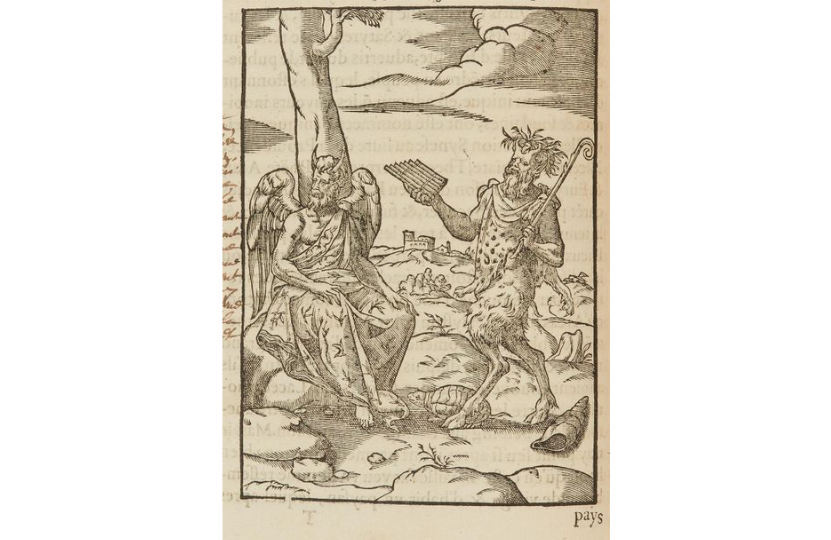
Cartari décentré. Les Images des dieux dans l’Europe de la première modernité (XVIe-XVIIIe siècles) (Université Paul Valéry - Montpellier 3)
(english version below) Cartari décentré : les Images des dieux dans l’Europe de la première modernité (XVIe-XVIIIe siècles) Colloque international, Université Paul Valéry - Montpellier 3, les 1 et 2 juin 2023 Les Imagini de i Dei de Vincenzo Cartari, publiées à Venise en 1556, proposent à l’attention des peintres et des poètes les descriptions et les interprétations des dieux païens antiques léguées par la tradition mythographique. L’ouvrage connaît un succès foudroyant : plus de trente-deux éditions, traductions et adaptations sont publiées et diffusées dans toute l’Europe jusqu’au XVIIIe siècle. Il constitue un témoignage de premier ordre pour comprendre la manière dont les lecteurs et spectateurs, les artistes et commanditaires appréhendaient les dieux païens de l’Antiquité. Il nous permet de restituer les interprétations – et, parfois, les contresens – auxquels ils étaient associés pendant la première modernité (XVIe-XVIIIe siècles), et d’éviter de projeter sur eux notre pensée du mythe de manière anachronique.
La critique s’est jusqu’à présent majoritairement intéressée au texte de Cartari dans sa langue originale, l’italien. Notre colloque, « Cartari décentré : Les Images des dieux dans l’Europe de la première modernité », propose de déplacer le regard en s’intéressant aux nombreuses éditions, adaptations et traductions de Cartari hors d’Italie, aux jeux d’estampes dont elles sont assorties et à la manière dont textes et images interagissent avec la production culturelle de l’aire géographico-linguistique concernée.
Un colloque international réunira à Montpellier, les 1er et 2 juin 2023, des spécialistes de littérature et d’histoire de l’art des aires culturelles française, néerlandaise, anglaise et allemande, et, nous l’espérons, d’autres encore. Il constituera une étape préparatoire à la publication d’un ouvrage collectif intitulé Cartari décentré : Les Images des dieux dans l’Europe de la première modernité.
Les communications pourront porter sur l’un des aspects suivants ou suggérer d’autres approches :
· Terminologie et traductologie: quels enjeux liés à la traduction du texte de Cartari de l’italien vers le latin et le français, puis de ces langues vers d’autres encore ?
· Aspects iconographiques liés à l’étude des différentes séries d’estampes associées aux éditions successives.
· Que nous enseignent les adaptations et les réécritures des Imagini sur les attentes du lectorat de l’aire géographico-culturelle concernée ?
· Transmédialité: comment ces différentes versions interagissent-elles avec les productions culturelles de l’époque, qui utilisent d’autres supports (théâtre, mascarades, entrées royales, poésie, roman, peinture, etc.)
· Quel rôle jouent les correcteurs, traducteurs, éditeurs, graveurs de ces différentes éditions ?
Merci de bien vouloir envoyer les propositions de communication (résumé de 200 mots environ) en français ou en anglais, assorties d’une courte notice bio-bibliographique, avant le 1er octobre 2022 à rachel.darmon@univ-montp3.fr et jan.blanc@unige.ch
Comité d'organisation
Rachel Darmon (maîtresse de conférences en littérature française du XVIe siècle à l’Université Paul Valéry-Montpellier 3 - IRCL, UMR 5186 du CNRS)
Jan Blanc (professeur d’histoire de l’art des temps modernes (XVe-XVIIIe siècles) à l’Université de Genève)
Comité scientifique
Jean Balsamo (Université de Reims)
Michèle Clément (Université de Lyon II)
Richard Cooper (Université d’Oxford)
Emmanuelle Hénin (Université de Paris-Sorbonne)
Mireille Huchon (Université de Paris-Sorbonne)
________________________
Decentred Cartari: Images of the Gods in early modern Europe International conference, Université Paul Valéry - Montpellier 3 1 and 2 June 2023
Vincenzo Cartari’s Imagini de i Dei, which was published in Venice in 1556, provides painters and poets with descriptions and interpretations of the ancient pagan gods handed down by the mythographic tradition. The work was immensely successful, with more than thirty-two editions, translations and adaptations published and circulated throughout Europe until the 18th century. It provides first-rate evidence of the ways in which readers and spectators, artists and patrons, understood the pagan gods of Antiquity. It enables us to invest them with the meanings – and, occasionally, counter-meanings – with which they were endowed at the time, without projecting anachronistically onto them our own perception of myth.
Until now, critics have been mainly interested in Cartari’s text in its original language, Italian. Our conference, “Cartari decentred: Images of the gods in early modern Europe”, proposes to shift the focus by considering the numerous editions, adaptations and translations of Cartari outside Italy, their sets of engravings and the ways in which texts and images interact with the cultural productions of the various geographic-linguistic areas.
An international conference will be held in Montpellier (France) on 1 and 2 June 2023, bringing together specialists in literature and art history from the French, Dutch, English, German, and – we hope – other cultural areas. It will be a preparatory stage for the publication of a collective volume entitled Decentred Cartari: Images of the Gods in Early Modern Europe.
Papers may focus on one of the following aspects or other approaches:
· Terminology and translatology: what are the issues involved in translating Cartari’s text from Italian into Latin and French, and from these languages into others?
· Iconographic aspects related to the study of the different sets of prints associated with the successive editions.
· What do adaptations and rewritings of the Imagini teach us about the expectations of the readership in the geo-cultural area concerned?
· Transmediality: how do these different versions interact with the cultural productions of the time, which use other media (theatre, masquerades, royal entries, poetry, novels, painting, etc.).
· What role do the proofreaders, translators, editors and engravers of these different editions play?
We welcome proposals for papers in French or English (abstract of about 200 words), with a short bio-bibliographical note, to be sent before 1 October 2022 to rachel.darmon@univ-montp3.fr and jan.blanc@unige.ch
Organization
Rachel Darmon (Associate Professor in 16th-century French literature at the Université Paul Valéry-Montpellier 3 – IRCL, CNRS)
Jan Blanc (professor of early modern art history (15th-18th centuries) at the Université de Genève)
Scientific Committee
Jean Balsamo (Université de Reims)
Michèle Clément (Université de Lyon II)
Richard Cooper (Oxford University)
Emmanuelle Hénin (Université de Paris-Sorbonne)
Mireille Huchon (Université de Paris-Sorbonne)